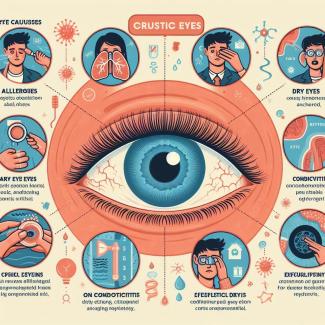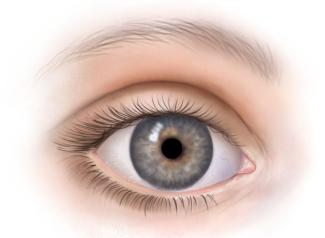
Crusty eyes, also known as "sleep" or "eye discharge," occur when mucus, oil, skin cells, or debris accumulate around the eyes during sleep. This phenomenon is typically harmless and often indicates the body's natural mechanism of clearing away irritants and debris. The crustiness forms when tears and natural lubricants mix with these substances, drying out overnight and creating a thin film around the eyelids and lashes. Factors contributing to crusty eyes include:
- Tears: Tears contain proteins, oils, and mucus to keep the eyes moist and protect against infection. During sleep, tears and their components may accumulate around the eyes, contributing to crust formation.
- Eye Irritation: Irritants like dust, pollen, smoke, or allergens can trigger increased tear production and eye discharge, leading to crustiness.
- Bacterial or Viral Infections: Infections such as conjunctivitis (pink eye) can cause increased eye discharge, which may dry and form crusts around the eyes.
- Blocked Tear Ducts: Conditions that obstruct the tear ducts, such as inflammation or structural abnormalities, can lead to poor drainage of tears, resulting in crusty eyes.
- Blepharitis: This condition involves inflammation of the eyelids, which can lead to increased oil production and the formation of crusts along the lash line.
- Contact Lenses: Wearing contact lenses, particularly for extended periods, can disrupt the tear film and increase the likelihood of crusty eyes.
- Dry Eye Syndrome: Insufficient tear production or poor tear quality can cause dryness and irritation, leading to crustiness upon waking.
- Exposure to Wind or Dry Air: Environmental factors like windy conditions or sleeping in a room with low humidity can exacerbate dryness and contribute to crust formation.
Generally, crusty eyes are harmless and resolve upon waking, often with gentle cleansing. However, persistent or severe symptoms, such as redness, pain, swelling, or changes in vision, may indicate an underlying issue requiring medical attention.
Crusty eyes in the morning, or sleep crust, is a combination of skin cells, tears, and mucus that accumulate naturally during sleep
Crusty eyes in the morning, commonly referred to as sleep crust, are a natural occurrence resulting from the accumulation of skin cells, tears, and mucus during sleep. These substances gather around the eyes, particularly along the lash line and in the corners, forming a thin, sometimes hardened layer upon waking. Sleep crust is typically harmless and easily removed with gentle washing or blinking.
While sleep crust is generally benign, it can sometimes serve as an indicator of an underlying issue, such as an eye infection or other ocular conditions. For example, bacterial or viral infections like conjunctivitis (pink eye) can lead to increased eye discharge, resulting in more pronounced or persistent crustiness. Additionally, conditions like blepharitis (inflammation of the eyelids) or dry eye syndrome may exacerbate the formation of sleep crust.
It's essential to pay attention to any changes in the frequency, consistency, or color of sleep crust, as well as accompanying symptoms such as redness, itching, swelling, or pain. These could suggest an underlying problem that requires medical evaluation and treatment. However, occasional or mild sleep crust without other symptoms is typically nothing to be concerned about and can be managed with good hygiene practices.
How to eliminate morning crust in the eyes or sleep crust, which naturally accumulates during sleep.
To effectively eliminate morning crust in the eyes, also known as sleep crust, follow these steps for gentle and thorough removal:
- Wash Your Hands: Before touching your eyes, wash your hands thoroughly with soap and water to prevent introducing any additional bacteria or dirt.
- Moisten with Warm Water: Moisten a clean washcloth or cotton pad with warm water. The warmth helps soften the crust and makes it easier to remove.
- Gently Wipe Away Crust: With your eyes closed, gently press the moistened cloth or pad against your eyelids and lashes. Use gentle, downward strokes to wipe away the crust, starting from the inner corner and moving towards the outer corner of the eye. Avoid rubbing or scrubbing, as this can irritate the delicate skin around the eyes.
- Repeat if Necessary: Depending on the amount of crust and its stubbornness, you may need to repeat the process a few times until the crust is fully removed.
- Use Eye Drops or Artificial Tears: If you experience dryness or irritation along with crustiness, consider using lubricating eye drops or artificial tears to help hydrate the eyes and prevent further crust formation.
- Avoid Touching Your Eyes: To minimize the risk of introducing bacteria or irritants, avoid touching or rubbing your eyes throughout the day, especially if your hands are not clean.
- Practice Good Hygiene: Maintain good eye hygiene by regularly washing your face and removing makeup before bedtime. Additionally, replace contact lenses as recommended by your eye care professional and clean them properly to prevent crust buildup.
- Seek Medical Attention if Necessary: If you experience persistent or severe crustiness, along with other symptoms such as redness, swelling, pain, or changes in vision, consult an eye care professional for further evaluation and treatment.
By following these steps, you can effectively eliminate morning crust in the eyes while promoting overall eye health and comfort.






